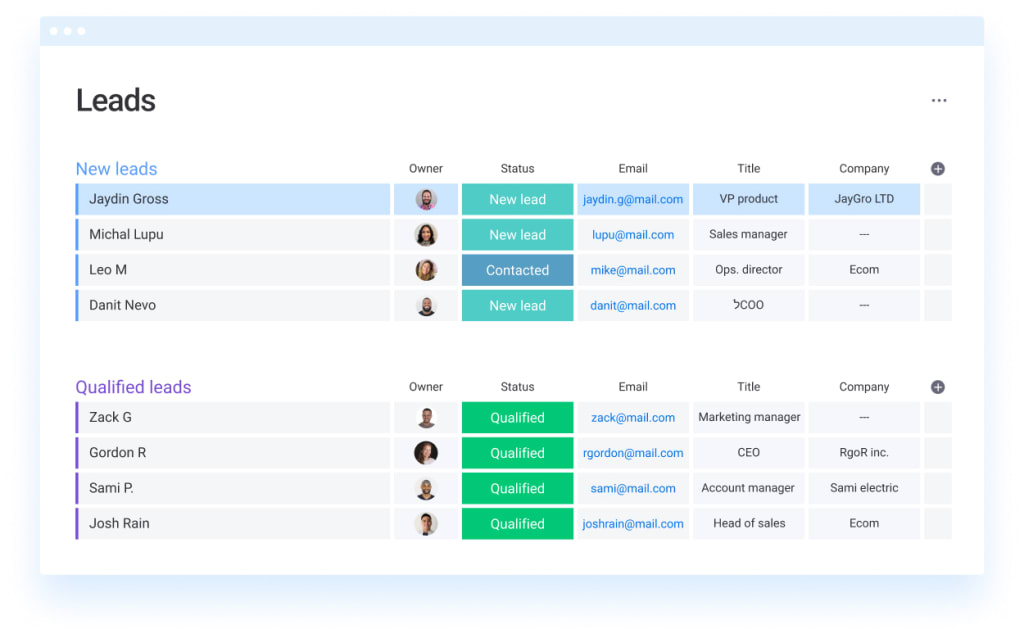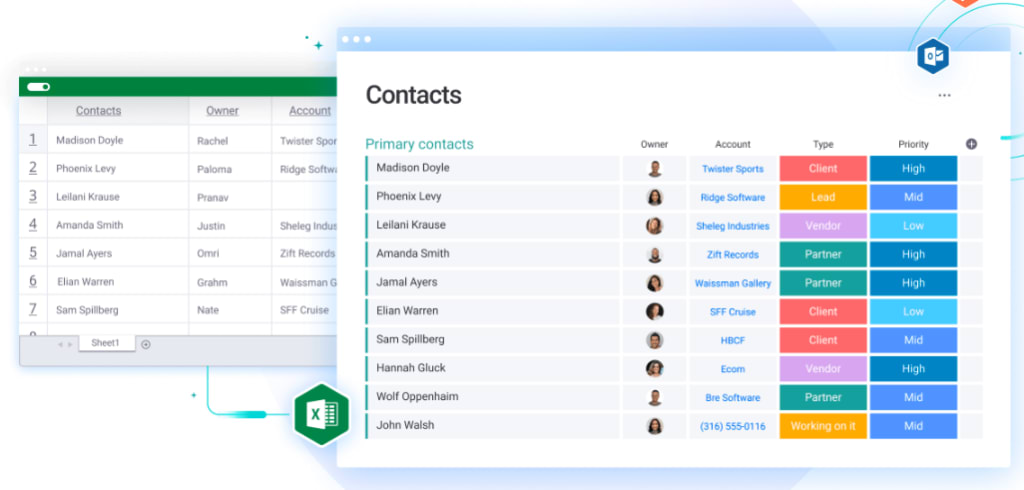The results that stem from a customer behavior analysis help companies gain insight into how customers interact with a business. For example, if customers purchase a product but never make a repeat purchase, a customer behavior analysis can help a business understand customers’ behavior and provide information that enables them to apply changes to its products or services or marketing to make additional sales.
In this post, we’ll explore the different steps of conducting a customer behavior analysis and also look at how a tool like monday sales CRM can help you achieve better results.
What is customer behavior analysis?
Customer behavior analysis is the process of gathering data about how customers interact with a business by studying their interactions with products, services, marketing messages, website features, and more.
It’s primarily used to understand customer preferences, habits, and needs in order to better target and personalize a company’s offerings.
By gathering and analyzing customer behavior, businesses can optimize the customer experience and develop effective campaigns. The process can also reveal potential problems or opportunities that could lead to increased ROI, such as identifying customer segments that may be more likely to convert or uncovering customer pain points that can be addressed.
What makes analyzing customer behavior important?
Analyzing customer behavior allows businesses to better understand their customers and identify preferences, needs, and motivations. With this data, businesses can effectively tailor products and services to meet consumers’ expectations, and drive sales, all while keeping and growing their customer base. Let’s take a closer look at some key benefits of performing a customer behavior analysis.
- Provide better service: Understanding consumer behavior can help businesses find opportunities to improve customer experience, leading to increased satisfaction.
- More accurate personalization: Research shows that 71% of customers now expect personalization when they shop. Understanding customer behavior can help businesses create personalized offers that better meet customers’ preferences.
- Improve content: Better tailor content to be more relevant and engaging to your customers, leading to increased conversions.
- Find new customers: Analyzing customer behavior can help businesses identify new customers who share similar behaviors to current customers.
- Retain customers: By gathering information to inform your understanding of customers’ needs and preferences, you can increase customer loyalty and retain more clients.
- Increase marketing ROI: Optimize your marketing campaigns to reach the right people with the right message.
6 steps to conduct an effective customer behavior analysis
Depending on your company and specific goals with running a customer behavior analysis, some steps might require more attention than others. Let’s go through the different steps and what’s involved in each.
1. Segment your audience
Before you begin the actual analysis, you want to divide your audience into segments to make it easier to analyze them and also to ensure more accurate results that reflect the diversity in your client base.
You can choose to segment your audience using different metrics, such as:
- Demographic: age, gender
- Geographic: specific or general location such as country, state, or city
- Psychographics: values, opinions, lifestyle
- Interests: hobbies, likes
- Behavior: search or browsing behavior, previous purchases, job title
You can also look at other details such as what device they’re browsing on or where else they shop to get a more well-rounded overview of what your customers are like. After gathering data on these metrics, group your audience into segments based on similarities. This will enable you to develop strategies that correspond to specific customer values, needs, and preferences.
Read also: How to keep accurate data with data enrichment.
2. Identify key selling points
Once you’ve narrowed down your segments, it’s time to identify key selling points for each one. This is why gathering data on things like demographics, interests, and previous behavior is so important; each segment will likely have its own unique selling point.
A good way to begin identifying selling points is to build customer personas with the data gathered during the segmenting stage. Try and understand what motivates each persona to convert. Is it due to necessity, a specific pain point they’re looking to address or was it an impulse buy? Does your audience research before making a purchase or look at competitors? Answering questions like this will help you identify different selling points so that you can better target your campaigns, products, and services in the future.
3. Gather as much data as possible
This step can be divided into gathering qualitative and quantitative data.
Qualitative data is what you’ve already gathered in the first two steps, such as customer purchase behavior, demographics, or shopping habits.
Quantitative data, on the other hand, is numerical data that can be measured and compared. To run a successful customer behavior analysis, you’ll need a good sample size of both.
To start gathering qualitative above and beyond the information you gathered from segmenting your audiences, you can:
- Conduct interviews
- Run surveys
- Establish focus groups
- Gather customer reviews
- Browse forums
- Employ social listening
For quantitative data, there are different ways to gather information:
- Surveys
- A/B tests
- Feedback forms
- Web analytics
- Customer ratings
Read also: Get insights through customer data analysis
4. Compare quantitative and qualitative data
Once you’ve gathered both types of data, you’ll want to compare the two to see if your findings line up. You might notice some recurring trends between the two sets of data, or that the same customer pain points arise.
This will help you identify trends and give you some areas to focus on for improving customer experience. You might also be able to identify which customer segments are your higher value clients, which need more nurturing, as well as enlighten you about different audiences that you may not have tapped into yet.
5. Use your results to optimize your customer journey and campaigns
After comparing both data sets and getting a detailed analysis of customer behavior, you’re ready to apply your results to your campaigns in order to optimize them. Additionally, you can use your results to inform different levels of the customer journey so that you can better capture customers at each stage.
The results of your customer behavior analysis can be used in a number of different ways, for example:
- Optimize existing marketing campaigns or create new ones to address specific customer personas and behaviors
- Run new social campaigns based on key selling points for specific audience segments
- Add personalizations to the customer journey to incentivize customers to convert
These are just a few ideas of where to begin with your customer behavior analysis results, but the data you gather can inform decisions you make throughout your pipeline, from lead collecting and nurturing all the way up to post-sale service.
6. Analyze, adjust, and repeat
Of course, as with any new tweak you make to existing strategies or new campaigns you promote, you always need to analyze whether the changes you made have an impact or if you need to make further adjustments.
After you’ve applied your data to make changes to your campaigns and customer journey, use analytics and metrics to gauge whether they’ve been effective. You can look at things like conversion rate, customer acquisition cost, customer lifetime value, and others to assess the changes in your campaign.
Additionally, you can redo parts of your customer behavior analysis, such as gathering new data to see if there are any areas you missed. Customer needs and preferences are likely to change over time, so it’s always a good idea to monitor and adjust your behavior analysis and its results at regular intervals.
Try monday sales CRMEasily manage your customer behavior analysis with monday sales CRM
The success of your customer behavior analysis depends on a number of factors:
- The amount of data you collect
- The quality of the data
- The comparison process
- How you apply the results to your campaigns
However, another factor that can determine success is the tool you use to help you organize your analysis. It’s essential to have a platform that will help you manage all the data you’re using clearly and efficiently. That’s where monday sales CRM comes in.
Let’s take a look at some key features of monday sales CRM to understand how it can help you run a behavior analysis successfully.
Segment audiences with visual boards

With monday sales CRM, you can create multiple customizable boards to store customer information for each of your segmented lists. This will enable you to work on one segment at a time while storing all the relevant data in an organized way.
Gain control of your data

You can import your existing data such as contacts, leads, and accounts from Excel or through an API, as well as merge duplicate data, and capture new leads all in one tool. This will help when you’re trying to tap into new audiences after your customer behavior analysis.
Third-party integrations & apps to collect your data in one place

monday sales CRM integrates with many popular third-party apps, such as SurveyMonkey, JotForm, Data Studio, and more. If you use apps to run surveys or collect data to generate insights and reports, you can rest assured that the data will be transferred to your monday sales CRM so you can keep track of everything in one place.
Try monday sales CRMFAQ
What are the 4 types of customer buying behavior?
The four types of customer buying behavior include complex buying behavior, dissonance-reducing buying behavior, habitual buying behavior, and variety-seeking customer. Each one defines the factors and conditions that go into customer purchase decisions.
What are the five consumer behavior approaches?
The five consumer behavior approaches are defined as the economic man, psychodynamic, behaviorist, cognitive, and humanistic. Each approach defines a different method for the study of consumer behavior.
What affects consumer behavior?
Anything from culture, personal or social factors, psychology, situational factors, and marketing can have an effect on consumer behavior.
Streamline customer behavior analysis with a superior CRM
A CRM will help you improve your data collection by providing you with a platform to keep, track, and analyze all your data. monday sales CRM is a great choice since it enables you to integrate tools you already use and is highly customizable so that you can create boards that meet your needs for your business’s specific analysis.

